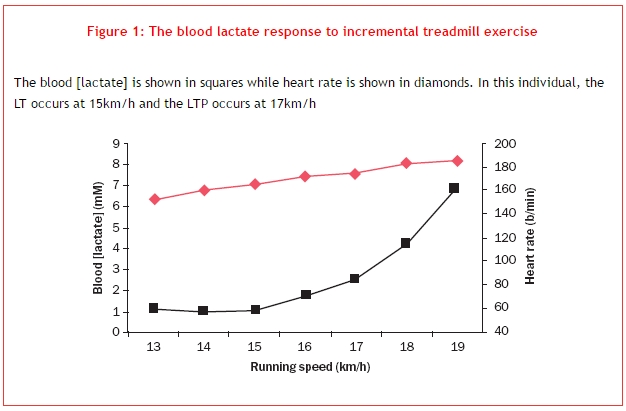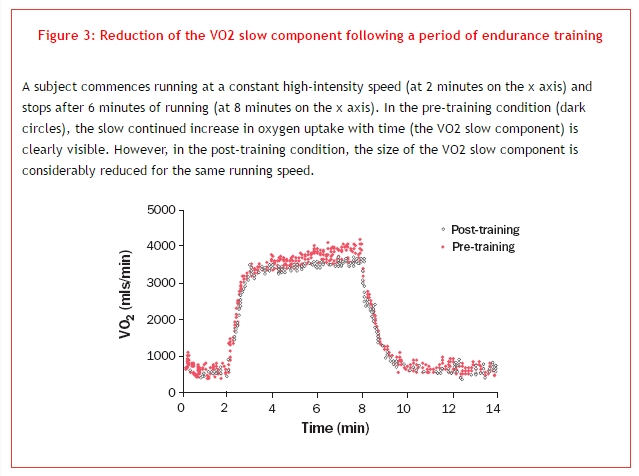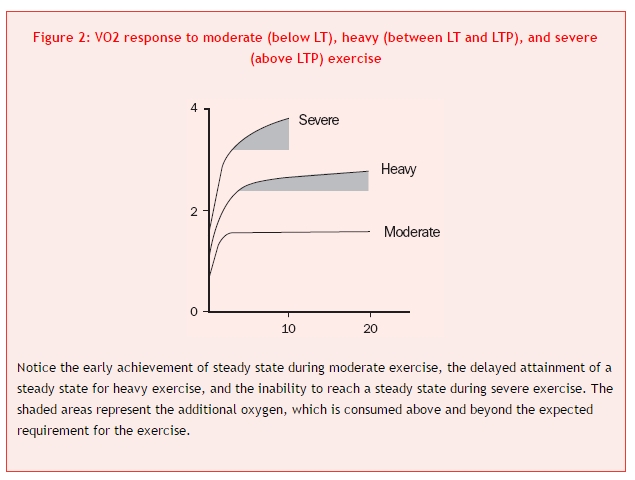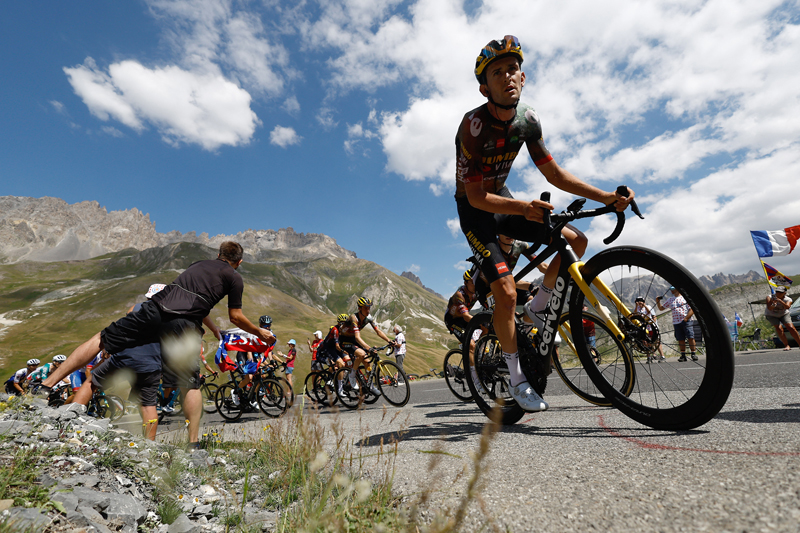You are viewing 1 of your 1 free articles. For unlimited access take a risk-free trial
The ‘slow component’ of VO2 – understand it to go faster!
Practical recommendations for reducing the impact of the VO2 slow component
Article at a glance- The traditional way of classifying ‘exercise intensity’ is discussed;
- The concept of exercise intensity ‘domains’ is introduced;
- The VO2 ‘slow component’ is described and its importance to exercise performance is explained;
- Practical recommendations for reducing the impact of the VO2 slow component are provided.
Imagine that you begin walking at a very comfortable pace on a treadmill and every few minutes the speed of the treadmill belt is progressively increased so that you need to break into a slow jog, then a faster jog, then a run, and finally a sprint. Although the walking or running speed might have increased in a linear fashion, your perception of the difficulty of the exercise challenge would almost certainly not be linear; there will come a point at which the exercise will quickly switch from feeling quite manageable, to not feeling sustainable for very much longer, and then to feeling intolerable. This is well known, but what is the physiological explanation?
To answer this question, we must first appreciate what is meant by the term ‘exercise intensity’. The intensity at which exercise is performed has traditionally been described in terms of the fraction of the maximal oxygen uptake (VO2max) that the exercise requires in the ‘steady state’. Here, the steady state refers to the plateau in oxygen uptake that is reached following a few minutes of exercise.
For example, running at a speed of 12km/h might require only 50% of the VO2max of a well-trained distance runner but as much as 75% of the VO2max of a recreational games player. However, there are two implicit assumptions in the practice of using the fraction of VO2max to describe (and also to prescribe) exercise intensity.
The first assumption is that a steady state in oxygen uptake is always attained irrespective of the speed at which an individual is walking or running, cycling, etc. The second is that two individuals who are exercising at the same fraction of their VO2max are experiencing a physiological strain that is essentially the same and are also perceiving the exercise to be equally easy (or difficult). As we shall see, these assumptions are untenable, but to understand why, it’s necessary to describe the various exercise intensity domains that have been identified and the physiological ‘thresholds’ which separate them.
Exercise intensity domains
For most individuals, walking on a treadmill at a leisurely pace will be comfortable. If, after a few minutes of walking, a small blood sample is taken and the concentration of blood lactate is measured (blood [lactate]), it is likely that it will be very similar to the value measured at rest (approximately 1 millimole per litre or 1mM). This means that the exercise is being performed below the so-called ‘lactate threshold’ (LT).However, at some specific higher speed (which will vary from individual to individual), the blood [lactate] will be elevated above the value measured at rest, indicating that the exercise is now being performed above the LT (see figure 1).

As the walking or running speed becomes increasingly faster, the blood [lactate] will increase more and more steeply. Blood [lactate] tends to increase quite slowly until a value of about 3-4mM is reached but, thereafter, the accumulation of lactate seems to accelerate (see figure 1). This point of transition from slow to much faster accumulation of blood lactate has been termed the ‘lactate turnpoint’ (LTP).
Depending on the training status of the individual and the type of exercise being performed, the LT often occurs somewhere between 50% and 80% of the VO2max, whereas the LTP is higher and usually lies between 70% and 90% of the VO2max. The LT has been shown to be a good predictor of performance in long-distance events taking two or more hours such as the marathon, while the LTP (which, incidentally, is roughly equivalent to the so-called ‘maximal lactate steady state’, MLSS) is more closely associated with shorter endurance events such as the 10K run(1).
The pattern of blood lactate accumulation during so-called incremental exercise tests such as that described above is often used to assess changes in fitness resulting from participation in a training programme, or indeed to recommend certain types of training which might bring about specific training effects. It is interesting, therefore, to examine what happens both to blood [lactate] and to other physiological variables such as oxygen uptake when an individual exercises for quite a long period of time at a constant speed that is:
- Below the LT;
- Between the LT and the LTP;
- Above the LTP.
- During prolonged exercise at a speed below LT, blood [lactate] is maintained at very close to the resting value (apart from, possibly, a very small and short-lived rise over the first 1-2 minutes) and oxygen uptake rises rapidly following the onset of exercise to reach a steady state within about 2-3 minutes (see figure 2). This exercise intensity ‘domain’ (ie, below the LT) has been termed ‘moderate’.
- A constant speed above the LT but still below the LTP: In this case, blood [lactate] rises above the resting value and only levels off after some 10-20 minutes. Interestingly, oxygen uptake follows a similar overall time course (see figure 2). Compared to exercise below the LT, oxygen uptake rises relatively slowly, and the achievement of a steady state is delayed. Furthermore, the eventual steady state value is higher than might have been predicted suggesting that exercise efficiency has been impaired. The exercise intensity domain lying between the LT and the LTP has been described as ‘heavy’.
- A constant speed above the LTP: In this situation, blood [lactate] increases steeply following the onset of exercise and continues to increase until the individual becomes exhausted and has to slow down or stop. By definition, blood [lactate] can never stabilise during exercise performed above the LTP, and the higher the speed above the LTP, the more rapidly blood [lactate] will increase. The important point, however, again is that the pattern of response of oxygen uptake is very similar to that of the blood [lactate]. Oxygen uptake initially rises towards the predicted steady state but then continues to rise with time, showing no sign of abating, until the exercise is stopped (see figure 2). This exercise intensity domain has been termed ‘severe’.
The VO2 ‘slow component’
The continued increase in oxygen uptake as time progresses both in the heavy exercise intensity domain (where oxygen uptake will eventually stabilise at a higher than expected level) and in the severe exercise intensity domain (where it will not stabilise) is known as the ‘VO2 slow component’(2).The VO2 slow component is particularly interesting to exercise physiologists because it indicates that the efficiency with which the body uses oxygen to produce energy is progressively lost while exercise continues at exactly the same speed. In fact, it has been shown that if exercise is continued for long enough the VO2max can be attained even though the exercise was predicted to be, and started out being, sub-maximal(3)!
What does this mean in practice? Let’s assume that an athlete completes an incremental treadmill test and her LTP occurs at 13km/h, corresponding to approximately 75% VO2max. If the athlete subsequently performs a continuous run at 14 km/h, she might expect her oxygen uptake to stabilise at perhaps 80% of her VO2max after a few minutes. In other words, the running speed she has chosen should be sub-maximal.
“The VO2 slow component is particularly interesting to exercise physiologists because it indicates that the efficiency with which the body uses oxygen to produce energy is progressively lost while exercise continues at exactly the same speed”
However, what will actually happen is that her oxygen uptake (and, indeed, her heart rate [HR]) will continue to increase with time as she maintains the same ‘sub-maximal’ running speed until she reaches her VO2max (and her maximal heart rate, HR max).
Once VO2max and HR max are reached, the only way that the exercise can be continued is if the additional energy that is required is supplied by anaerobic mechanisms. These mechanisms have limited capacity and, thus, once the VO2 slow component brings the oxygen uptake up to the VO2max, exercise can only be sustained for a very short period of time. In plain English, a run which should have been sub-maximal has actually turned out to be maximal (and exhausting)!
The importance of the VO2 slow component – an example
If two athletes are exercising at the same fraction of their VO2max, then it has been conventionally assumed that they are experiencing the same physiological strain, will perceive the exercise to be similarly difficult (or easy), and should benefit equally from continued exposure to the same training stimulus. But is this second assumption, for the description and prescription of exercise intensity using fractions of the VO2max, valid?
The answer to the question depends upon where the LT and LTP lie in relation to the VO2max for each of the athletes. For example, let’s say that athlete A’s LT occurs at 65% of his VO2max and his LTP occurs at 85% of his VO2max, while athlete B’s LT occurs at 55% of his VO2max and his LTP occurs at 75% of his VO2max.
If both athletes perform a continuous running session at the same speed, which corresponds to 60% of their VO2max, athlete A will be exercising below his LT while athlete B will be exercising above his LT. Athlete A will therefore be exercising in the ‘moderate’ domain (in which blood [lactate] will remain close to the resting value and an early steady state in oxygen uptake will be attained) whereas athlete B will be exercising in the ‘heavy’ domain (in which blood [lactate] will be elevated above baseline and a steady state in oxygen uptake will be delayed).
Similarly, if both athletes complete a continuous run at 80% of their VO2max, athlete A will be exercising below his LTP while athlete B will be exercising above his LTP. Athlete A will be exercising in the ‘heavy’ domain such that blood [lactate] and oxygen uptake will attain delayed steady state values, whereas athlete B will be exercising in the ‘severe’ domain in which blood [lactate] will rise inexorably throughout exercise and the VO2 slow component will drive oxygen uptake to its maximum.
For athlete A, this latter training session will be tough but manageable but, for athlete B, it will be seem very hard and might not even be sustainable beyond 20-30 minutes. It can be seen from the above that although the two hypothetical athletes were training at the same fraction of VO2max (at least at the beginning of the two training sessions), the physiological and perceptual responses to the exercise would have been very different. Athlete B would have been training much harder than athlete A in both sessions and, while this might lead to more rapid short-term fitness gains, it might also result in chronic overtraining.
This illustration reinforces the importance for athletes and coaches to understand the physiological significance of the exercise intensity domains that are bounded by the LT and LTP and to appreciate the impact that the VO2 slow component will have on the prescription of exercise intensity.
The existence of the VO2 slow component means that the assumption that a steady state in oxygen uptake will always be attained irrespective of the speed at which an individual is exercising is untenable. Rather, for any individual, there will be a wide range of exercise speeds for which a steady state in oxygen uptake or HR cannot be attained.
This obviously has important implications for the design of training sessions. For example, if a coach asks an athlete to perform a continuous exercise session at a constant speed and at a HR corresponding to, say, 90% of the maximum, it will not be possible for the athlete to satisfy both requests. If the athlete maintains the desired exercise speed, then the HR will increase over time from 90% early in the session towards the maximum as the session proceeds. Alternatively, if the athlete sticks rigidly to the prescribed HR, then he or she would have to gradually reduce the exercising speed during the training session.
While there is no question that either of these two outcomes might still produce positive training effects, the point being made here is that coaches and athletes need to appreciate the limitations that the existence of the VO2 slow component will place upon their performance during exercise above the LTP.
What causes the VO2 ‘slow component’?
The physiological mechanism responsible for the loss of muscle efficiency, which is reflected in the VO2 slow component phenomenon, is obscure (4). However, one theory is that it is related to the progressive recruitment of fast-twitch (or type II) muscle fibres during fatiguing high-intensity exercise.
At the onset of exercise, the central nervous system might activate a certain number of motor units (groups of muscle fibres), which it calculates should be sufficient to sustain the desired exercise speed. However, as high-intensity exercise continues and the initially recruited muscle fibres begin to fatigue, the central nervous system activates additional fresh motor units to ensure that the desired speed can be maintained.
The motor units that are recruited later in exercise will tend to be larger and to contain more fast-twitch muscle fibres, which although powerful, have relatively poor efficiency. This means that they have to consume more oxygen to produce the same amount of force as slow-twitch fibres.
Hence, during high-intensity exercise, as more and more fast-twitch fibres are recruited to enable the same speed to be maintained, the rate of oxygen uptake has to increase. At the same time, the muscle fibres that became fatigued earlier in exercise might continue to consume oxygen as they recover and this might also reduce efficiency and contribute to the VO2 slow component (4)
The VO2 ‘slow component’ and exercise performance
The VO2 slow component is intimately linked to the process of fatigue. For this reason, the higher the speed that can be sustained in the absence of the VO2 slow component, the better the prospects for endurance performance are.As you may have already surmised, the most effective way to reduce or eliminate the VO2 slow component for any given exercise speed is through endurance training. This will increase the LT and LTP and therefore shift the various exercise intensity domains to higher speeds (5). In this way, a speed that was initially ‘severe’ might become ‘heavy’ or even ‘moderate’ following training.
It has been repeatedly demonstrated that a general programme of endurance training can reduce the VO2 slow component (see figure 3). Quite possibly, the increase in the number of mitochondria (the ‘power-houses’ which use oxygen to produce energy) in the muscle cells resulting from endurance training will delay or reduce the activation of the ‘fast-twitch’ muscle fibres during high-intensity exercise. It is not yet known whether there is a specific type of training that is most effective for reducing the VO2 slow component but regular training in each of the three domains (moderate, heavy, and severe) should prove to be effective (6,7).

One other, more acute, way to reduce the impact of the VO2 slow component and thus enhance exercise performance is to complete a thorough warm-up before competition or hard training sessions. Evidence suggests that the warm-up should include several minutes of quite high-intensity exercise, which appears to increase the distribution of blood flow throughout the active muscles, pre-activate the metabolic pathways, and favourably alter the pattern of motor unit activation(8). As a consequence, the fatigue process is slowed down, the recruitment of fast-twitch muscle fibres is delayed, and the VO2 slow component can be minimised.
Summary
The existence of the VO2 slow component undermines both of the assumptions inherent in the traditional description (and prescription) of ‘exercise intensity’ using the fraction of VO2max expected to be required, namely that: 1) a steady state in oxygen uptake is always attained irrespective of the speed; and, 2) a given fraction of the VO2max represents the same physiological stress in different individuals. Clearly, in creating training programmes, coaches and athletes need to be aware of the exercise intensity ‘domains’ and the very different physiological responses to exercise that which pertain within them.Andrew M Jones PhD is professor of applied physiology at the University of Exeter.
References
- Med Sci Sports Exerc 1998 Aug; 30(8):1304-13
- J Appl Physiol 1972 Sep; 33(3):351-6
- Ergonomics 1988 Sep; 31(9):1265-79
- Med Sci Sports Exerc 2005 Sep; 37(9):1542-50
- Sports Med 2000 Jun; 29(6):373-86
- J Appl Physiol 2000 Nov; 89(5):1744-52
- Med Sci Sports Exerc 2006 Mar; 38(3):504-12
- Sports Med 2003; 33(13):949-71
Newsletter Sign Up
Testimonials
Dr. Alexandra Fandetti-Robin, Back & Body Chiropractic
Elspeth Cowell MSCh DpodM SRCh HCPC reg
William Hunter, Nuffield Health
Newsletter Sign Up
Coaches Testimonials
Dr. Alexandra Fandetti-Robin, Back & Body Chiropractic
Elspeth Cowell MSCh DpodM SRCh HCPC reg
William Hunter, Nuffield Health
Keep up with latest sports science research and apply it to maximize performance
Today you have the chance to join a group of athletes, and sports coaches/trainers who all have something special in common...
They use the latest research to improve performance for themselves and their clients - both athletes and sports teams - with help from global specialists in the fields of sports science, sports medicine and sports psychology.
They do this by reading Sports Performance Bulletin, an easy-to-digest but serious-minded journal dedicated to high performance sports. SPB offers a wealth of information and insight into the latest research, in an easily-accessible and understood format, along with a wealth of practical recommendations.
*includes 3 coaching manuals
Get Inspired
All the latest techniques and approaches
Sports Performance Bulletin helps dedicated endurance athletes improve their performance. Sense-checking the latest sports science research, and sourcing evidence and case studies to support findings, Sports Performance Bulletin turns proven insights into easily digestible practical advice. Supporting athletes, coaches and professionals who wish to ensure their guidance and programmes are kept right up to date and based on credible science.










